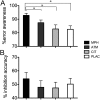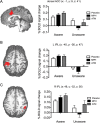Neurochemical enhancement of conscious error awareness
- PMID: 22357846
- PMCID: PMC6621889
- DOI: 10.1523/JNEUROSCI.4052-11.2012
Neurochemical enhancement of conscious error awareness
Abstract
How the brain monitors ongoing behavior for performance errors is a central question of cognitive neuroscience. Diminished awareness of performance errors limits the extent to which humans engage in corrective behavior and has been linked to loss of insight in a number of psychiatric syndromes (e.g., attention deficit hyperactivity disorder, drug addiction). These conditions share alterations in monoamine signaling that may influence the neural mechanisms underlying error processing, but our understanding of the neurochemical drivers of these processes is limited. We conducted a randomized, double-blind, placebo-controlled, cross-over design of the influence of methylphenidate, atomoxetine, and citalopram on error awareness in 27 healthy participants. The error awareness task, a go/no-go response inhibition paradigm, was administered to assess the influence of monoaminergic agents on performance errors during fMRI data acquisition. A single dose of methylphenidate, but not atomoxetine or citalopram, significantly improved the ability of healthy volunteers to consciously detect performance errors. Furthermore, this behavioral effect was associated with a strengthening of activation differences in the dorsal anterior cingulate cortex and inferior parietal lobe during the methylphenidate condition for errors made with versus without awareness. Our results have implications for the understanding of the neurochemical underpinnings of performance monitoring and for the pharmacological treatment of a range of disparate clinical conditions that are marked by poor awareness of errors.
Figures





Similar articles
-
Dissociable and common effects of methylphenidate, atomoxetine and citalopram on response inhibition neural networks.Neuropsychologia. 2014 Apr;56:263-70. doi: 10.1016/j.neuropsychologia.2014.01.023. Epub 2014 Feb 8. Neuropsychologia. 2014. PMID: 24513025 Clinical Trial.
-
Common and unique therapeutic mechanisms of stimulant and nonstimulant treatments for attention-deficit/hyperactivity disorder.Arch Gen Psychiatry. 2012 Sep;69(9):952-61. doi: 10.1001/archgenpsychiatry.2011.2053. Arch Gen Psychiatry. 2012. PMID: 22945622 Clinical Trial.
-
Methylphenidate but not atomoxetine or citalopram modulates inhibitory control and response time variability.Biol Psychiatry. 2011 May 1;69(9):902-4. doi: 10.1016/j.biopsych.2010.11.014. Epub 2010 Dec 30. Biol Psychiatry. 2011. PMID: 21193172 Clinical Trial.
-
Comparative efficacy and acceptability of atomoxetine, lisdexamfetamine, bupropion and methylphenidate in treatment of attention deficit hyperactivity disorder in children and adolescents: a meta-analysis with focus on bupropion.J Affect Disord. 2015 Jun 1;178:149-59. doi: 10.1016/j.jad.2015.03.006. Epub 2015 Mar 13. J Affect Disord. 2015. PMID: 25813457 Review.
-
Conscious perception of errors and its relation to the anterior insula.Brain Struct Funct. 2010 Jun;214(5-6):629-43. doi: 10.1007/s00429-010-0261-1. Epub 2010 May 29. Brain Struct Funct. 2010. PMID: 20512371 Free PMC article. Review.
Cited by
-
Methylphenidate enhances executive function and optimizes prefrontal function in both health and cocaine addiction.Cereb Cortex. 2014 Mar;24(3):643-53. doi: 10.1093/cercor/bhs345. Epub 2012 Nov 16. Cereb Cortex. 2014. PMID: 23162047 Free PMC article.
-
ADHD & Pharmacotherapy: Past, Present and Future: A Review of the Changing Landscape of Drug Therapy for Attention Deficit Hyperactivity Disorder.Ther Innov Regul Sci. 2015 Sep;49(5):632-642. doi: 10.1177/2168479015599811. Ther Innov Regul Sci. 2015. PMID: 26366330 Free PMC article.
-
Spatial and temporal characteristics of error-related activity in the human brain.J Neurosci. 2015 Jan 7;35(1):253-66. doi: 10.1523/JNEUROSCI.1313-14.2015. J Neurosci. 2015. PMID: 25568119 Free PMC article.
-
The balanced mind: the variability of task-unrelated thoughts predicts error monitoring.Front Hum Neurosci. 2013 Nov 7;7:743. doi: 10.3389/fnhum.2013.00743. eCollection 2013. Front Hum Neurosci. 2013. PMID: 24223545 Free PMC article.
-
Cognitive-affective neural plasticity following active-controlled mindfulness intervention.J Neurosci. 2012 Oct 31;32(44):15601-10. doi: 10.1523/JNEUROSCI.2957-12.2012. J Neurosci. 2012. PMID: 23115195 Free PMC article. Clinical Trial.
References
-
- Aron AR, Dowson JH, Sahakian BJ, Robbins TW. Methylphenidate improves response inhibition in adults with attention-deficit/hyperactivity disorder. Biol Psychiatry. 2003;54:1465–1468. - PubMed
-
- Aston-Jones G, Cohen JD. An integrative theory of locus coeruleus-norepinephrine function: adaptive gain and optimal performance. Annu Rev Neurosci. 2005;28:403–450. - PubMed
-
- Barnes JJ, Dean AJ, Nandam LS, O'Connell RG, Bellgrove MA. The molecular genetics of executive function: role of monoamine system genes. Biol Psychiatry. 2011;69:e127–e143. - PubMed
-
- Berridge CW, Devilbiss DM, Andrzejewski ME, Arnsten AF, Kelley AE, Schmeichel B, Hamilton C, Spencer RC. Methylphenidate preferentially increases catecholamine neurotransmission within the prefrontal cortex at low doses that enhance cognitive function. Biol Psychiatry. 2006;60:1111–1120. - PubMed
Publication types
MeSH terms
Substances
LinkOut - more resources
Full Text Sources
Other Literature Sources
